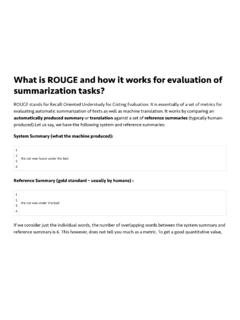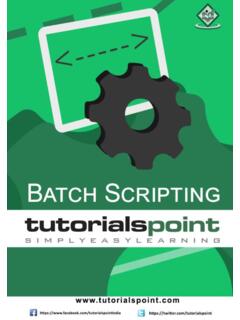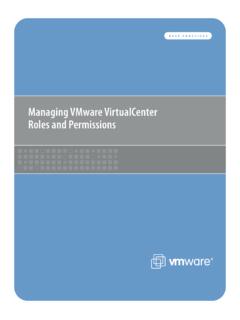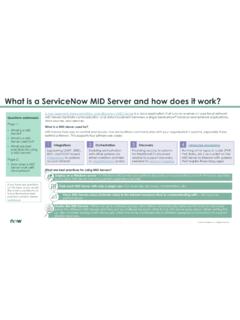Transcription of Perl - Tutorialspoint
1 perl i About the Tutorial perl is a programming language developed by Larry Wall, especially designed for text processing. It stands for Practical Extraction and Report Language. It runs on a variety of platforms, such as Windows, Mac OS, and the various versions of UNIX. This tutorial provides a complete understanding on perl . Audience This reference has been prepared for beginners to help them understand the basic to advanced concepts related to perl Scripting languages. Prerequisites Before you start practicing with various types of examples given in this reference, we are making an assumption that you have prior exposure to C programming and Unix Shell. Copyright & Disclaimer Copyright 2015 by Tutorials Point (I) Pvt. Ltd. All the content and graphics published in this e-book are the property of Tutorials Point (I) Pvt. Ltd. The user of this e-book is prohibited to reuse, retain, copy, distribute or republish any contents or a part of contents of this e-book in any manner without written consent of the publisher.
2 We strive to update the contents of our website and tutorials as timely and as precisely as possible, however, the contents may contain inaccuracies or errors. Tutorials Point (I) Pvt. Ltd. provides no guarantee regarding the accuracy, timeliness or completeness of our website or its contents including this tutorial. If you discover any errors on our website or in this tutorial, please notify us at perl ii Table of Contents About the Tutorial .. i Audience .. i Prerequisites .. i Copyright & Disclaimer .. i Table of Contents .. ii PART 1: perl BASICS .. 1 1. perl Introduction .. 2 What is perl ? .. 2 perl Features .. 2 perl and the Web .. 3 perl is Interpreted .. 3 2. perl Environment .. 4 Unix and Linux Installation .. 5 Running perl .. 6 3. perl Syntax Overview .. 9 Script Mode Programming .. 9 4. perl Data Types .. 15 Numeric 15 String Literals .. 16 5. perl Variables.
3 19 Creating Variables .. 19 6. perl Scalars .. 23 Scalar Operations .. 25 7. perl Arrays .. 28 8. perl Hashes .. 39 9. perl 45 if statement .. 46 statement .. 48 statement .. 50 unless statement .. 51 statement .. 53 statement .. 55 switch statement .. 56 The ? : Operator .. 59 10. perl Loops .. 61 while loop .. 62 perl iii until loop .. 64 for loop .. 66 foreach loop .. 68 loop .. 70 nested loops .. 71 Loop Control Statements .. 74 next statement .. 74 last statement .. 77 continue statement .. 80 redo statement .. 82 goto statement .. 83 The Infinite Loop .. 86 11. perl Operators .. 87 What is an Operator? .. 87 perl Arithmetic Operators .. 87 perl Equality Operators .. 89 perl Assignment 94 perl Bitwise Operators .. 96 perl Logical Operators .. 98 Quote-like Operators .. 100 Miscellaneous Operators .. 101 perl Operators 103 12. perl Date and Time .. 106 GMT Time .. 107 Format Date & Time.
4 107 Epoch time .. 108 POSIX Function strftime() .. 109 13. perl Subroutines .. 112 Define and Call a Subroutine .. 112 Passing Arguments to a Subroutine .. 113 Passing Lists to Subroutines .. 114 Passing Hashes to Subroutines .. 114 Returning Value from a Subroutine .. 115 Private Variables in a Subroutine .. 116 Temporary Values via local() .. 117 State Variables via state() .. 118 Subroutine Call Context .. 119 14. perl References .. 121 Create References .. 121 Dereferencing .. 122 Circular References .. 123 References to Functions .. 124 perl iv 15. perl Formats .. 126 Define a Format .. 126 Using the Format .. 127 Define a Report Header .. 128 Number of Lines on a Page .. 131 Define a Report Footer .. 131 16. perl File I/O .. 132 Opening and Closing Files .. 132 Open Function .. 132 Sysopen Function .. 134 Close Function .. 135 The <FILEHANDL> Operator .. 135 getc Function .. 136 read Function.
5 136 print Function .. 136 Copying Files .. 137 Renaming a file .. 137 Deleting an Existing File .. 138 Positioning inside a File .. 138 File Information .. 139 17. perl Directories .. 142 Display all the Files .. 142 Create new Directory .. 144 Remove a directory .. 144 Change a Directory .. 144 18. perl Error Handling .. 145 The if statement .. 145 The unless Function .. 145 The ternary Operator .. 146 The warn Function .. 146 The die Function .. 146 Errors within Modules .. 146 The carp Function .. 147 The cluck Function .. 148 The croak Function .. 149 The confess Function .. 149 19. perl Special Variables .. 151 Special Variable Types .. 152 Global Scalar Special Variables .. 152 Global Array Special Variables .. 156 Global Hash Special Variables .. 157 Global Special Filehandles .. 157 Global Special Constants .. 157 Regular Expression Special Variables .. 158 Filehandle Special Variables.
6 158 perl v 20. perl Coding Standard .. 160 21. perl Regular Expressions .. 163 The Match Operator .. 163 Match Operator Modifiers .. 165 Matching Only Once .. 165 Regular Expression Variables .. 166 The Substitution Operator .. 166 Substitution Operator Modifiers .. 167 The Translation Operator .. 167 Translation Operator Modifiers .. 168 More Complex Regular Expressions .. 169 Matching Boundaries .. 172 Selecting Alternatives .. 172 Grouping Matching .. 173 The \G Assertion .. 174 Regular-expression Examples .. 175 22. perl Sending Email .. 180 Using sendmail Utility .. 180 Using MIME::Lite Module .. 181 Using SMTP 184 PART 2: perl ADVANCED TOPICS .. 185 23. perl Socket Programming .. 186 What is a Socket? .. 186 Server Side Socket Calls .. 187 Client Side Socket Calls .. 189 Client - Server 190 24. perl OOP in perl .. 193 Object 193 Defining a Class .. 193 Creating and Using Objects.
7 194 Defining Methods .. 195 Inheritance .. 197 Method Overriding .. 199 Default Autoloading .. 201 Destructors and Garbage Collection .. 202 Object Oriented perl Example .. 203 25. perl Database Access .. 206 Database Connection .. 207 INSERT Operation .. 208 READ Operation .. 209 UPDATE Operation .. 210 DELETE Operation .. 211 perl vi COMMIT Operation .. 212 ROLLBACK Operation .. 212 Begin Transaction .. 212 AutoCommit Option .. 213 Automatic Error Handling .. 213 Disconnecting Database .. 213 Some Other DBI Functions .. 214 Methods Common to All Handles .. 216 26. perl CGI Programming .. 218 What is CGI ? .. 218 Web Browsing .. 218 CGI Architecture Diagram .. 219 Web Server Support and Configuration .. 219 First CGI 219 Understanding HTTP Header .. 220 CGI Environment Variables .. 221 GET and POST Methods .. 223 Passing Information using GET Method .. 223 Simple URL Example : Get Method .. 224 Simple FORM Example: GET Method.
8 225 Passing Information using POST Method .. 225 Passing Checkbox Data to CGI Program .. 227 Passing Radio Button Data to CGI Program .. 229 Passing Text Area Data to CGI 230 Passing Drop Down Box Data to CGI Program .. 232 Using Cookies in CGI .. 233 CGI Modules and Libraries .. 235 27. perl Packages and Modules .. 237 What are Packages? .. 237 BEGIN and END Blocks .. 238 What are perl Modules? .. 239 The Require Function .. 239 The Use Function .. 240 Create the perl Module Tree .. 241 Installing perl Module .. 242 28. perl Process Management .. 243 Backstick Operator .. 243 The system() Function .. 244 The fork() Function .. 245 The kill() Function .. 247 29. perl Embedded Documentation .. 248 What is POD? .. 249 POD 250 perl 7 Part 1: perl Basics perl 8 perl is a general-purpose programming language originally developed for text manipulation and now used for a wide range of tasks including system administration, web development, network programming, GUI development, and more.
9 What is perl ? perl is a stable, cross platform programming language. Though perl is not officially an acronym but few people used it as Practical Extraction and Report Language. It is used for mission critical projects in the public and private sectors. perl is an Open Source software, licensed under its Artistic License, or the GNU General Public License (GPL). perl was created by Larry Wall. perl was released to usenet's in 1987. At the time of writing this tutorial, the latest version of perl was perl is listed in the Oxford English Dictionary. PC Magazine announced perl as the finalist for its 1998 Technical Excellence Award in the Development Tool category. perl Features perl takes the best features from other languages, such as C, awk, sed, sh, and BASIC, among others. Perls database integration interface DBI supports third-party databases including Oracle, Sybase, Postgres, MySQL and others.
10 perl works with HTML, XML, and other mark-up languages. perl supports Unicode. perl is Y2K compliant. perl supports both procedural and object-oriented programming. perl interfaces with external C/C++ libraries through XS or SWIG. 1. perl INTRODUCTION perl 9 perl is extensible. There are over 20,000 third party modules available from the Comprehensive perl Archive Network (CPAN). The perl interpreter can be embedded into other systems. perl and the Web perl used to be the most popular web programming language due to its text manipulation capabilities and rapid development cycle. perl is widely known as " the duct-tape of the Internet". perl can handle encrypted Web data, including e-commerce transactions. perl can be embedded into web servers to speed up processing by as much as 2000%. perl 's mod_perl allows the Apache web server to embed a perl interpreter.

















